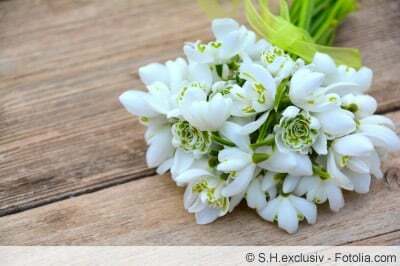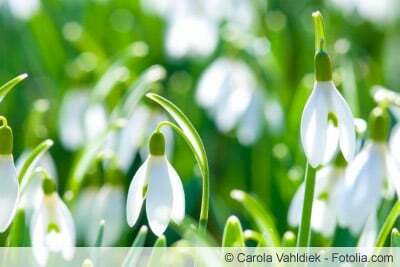

Table of contents
- Slightly toxic due to alkaloids
- people and animals affected
- First Aid Measures
- location and distribution
- appearance
- Tips for handling
- Put onions in wire basket
- clippings in the household waste
- Promising healing powers
- Conclusion
Regular media coverage of poisonous plants sensitizes hobby gardeners to their own ornamental and useful plants. This is all the more true when children and pets are in the garden, on the balcony or in the house. Anyone who gives up cultivating a plant species at the slightest suspicion is missing out on many a magical flower. In view of the clear differences in the toxic content, adequate handling can reduce or completely eliminate a possible hazard. Ask yourself no longer: are snowdrops poisonous? You should know that!
Slightly toxic due to alkaloids
As a genus of plants, snowdrops belong to the Amaryllis family. This circumstance implies that there are various alkaloids in the plant sap. Alkaloids are more than 10,000 naturally occurring organic compounds. The broad definition also includes well-known substances such as caffeine in coffee plants, Capsaicin in pepper plants, morphine in opium poppies or the autumn crocus alkaloid colchicine. It follows that the mere presence of an alkaloid does not necessarily mean life-threatening toxicity. However, the vast majority of these compounds are toxic to a greater or lesser extent. With regard to the poison content of snowdrops, the connection is as follows:
- The flower bulbs contain a slightly toxic amaryllidaceae alkaloid
- The leaves and flowers mainly contain lycorine, tazettin and galantamine
The highest concentration of alkaloids is found in the bulbs, while it is hardly detectable in the aerial parts of the plant.
people and animals affected
Snowdrops only have toxic effects after consumption. Simply taking a sniff of it does not have any negative consequences. This applies to both humans and animals, especially small pets such as dogs, cats and rodents. Here are the symptoms of poisoning:
- Increased salivation
- nausea and vomiting
- stomach pain
- Diarrhea
- sweats
- dizziness
A critical dose has not yet been determined by scientists. Experience has shown that eating more than 3 snowdrop bulbs can trigger the symptoms mentioned. If a significantly larger amount of snowdrop plant parts is eaten, paralysis can occur in the worst case.
First Aid Measures

After an intentional or unintentional consumption of up to 3 flower bulbs, the Poison center Bonn adequate administration of liquid, such as non-carbonated water or Tea. If an excess amount of leaves and flowers was ingested, the family doctor should be consulted. He decides whether the administration of a charcoal preparation is sufficient or whether detoxification in the clinic is necessary.
If the child is affected, it is definitely advisable to consult the responsible pediatrician, especially if the amount consumed cannot be precisely traced.
If symptoms of snowdrop poisoning appear in the pet to a pronounced extent, it should at least a telephone contact with the veterinarian should be made to decide how to proceed advise.
Tip:
Lily of the valley, which at first glance resembles snowdrops, is much more poisonous. As a result, lily of the valley was voted poisonous plant of the year in 2014, while snowdrop doesn't even come close to being nominated.
location and distribution
Snowdrops are native to all of Europe, from Asia Minor to the Caspian Sea. Since they tend to run wild, they populate large and small clearings in deciduous forests outside of gardens, thrive along the embankments at the edge of the road or on forest meadows. In the bed, the early bloomers are preferably planted in semi-shady locations under tall trees.
If snowdrops appear in your garden without you knowingly planting them out, busy ants are responsible for the flower blossom. The insects are very wild about the seeds, because a tasty nutritive substance sticks to them. On the way to the nest, the ants eat up part of the nutritive bodies, carelessly leave the seeds lying around, and in no time at all a young snowdrop will thrive.
appearance
In order to identify a snowdrop without a doubt, the following attributes are important:
- Two to three basal, linear leaves form the base
- A flower appears on the 2 to 30 centimeters high flower stalk
- It unfolds 3 white bracts on the outside and 3 smaller, green-white petals on the inside
- The spherical, 1 to 2 centimeters thick onion serves as an outlasting organ
The flowering period extends from February to April. Some rare species bloom into May. Therefore, the flowering period can collide with the more poisonous lily of the valley.
Tips for handling
If there are no children or pets in the garden or on the balcony, snowdrops pose no danger despite their slight poison content. In all other cases, the pretty spring flowers do not necessarily have to be dispensed with if the following precautions are taken:
Put onions in wire basket
Placing flower bulbs in a wire basket not only protects them from being bitten by pests such as voles. This measure prevents curiously digging dogs or cats from poisoning themselves with the nodules. How to do it right:
- At planting time in September, dig small planting holes 15 centimeters deep
- Position a wire basket with the lid open in each pit
- Spread a layer of sand of 2-3 centimeters on the sole
- Fill in the excavation and plant the snowdrop bulbs 7-8 centimeters deep
- Close the wire mesh lid tightly and cover with soil

If a wire basket is only used to protect against voles, there is no need for a cover, as the pests do not dare to come to the surface. If the mesh also acts as protection against digging pets, the close-meshed lid becomes more relevant. At least your four-legged friend cannot reach the flower bulb with the concentrated poison content. Children thirsty for knowledge on an expedition through the garden are only partially deterred from eating by this precaution.
clippings in the household waste
After flowering, the bulb feeds on all aerial parts of the plant to assimilate their nutrients. If the withered leaves and flowers of snowdrops bother you, cut them off. You should refrain from disposing of it in the compost if pets, grazing cattle or horses could get to it. In this case, the clippings go into the household waste. This should also be done if unwanted specimens were pulled out of the ground along with the bulb.
The same applies to snowdrops, which decorated the home in a vase, as a flower arrangement or in a planter and have now withered. Since the flower stalks release toxins into the flower water, vases should be placed out of the reach of children and pets.
Tip:
Snowdrops are not cultivated in the house at all if small children are left unsupervised, even for a short time. The risk of a flower bulb being eaten is too great. These concerns also apply to domestic cats and puppies.
Promising healing powers
The positive side of the coin should not go unmentioned in this context. The dominant alkaloid in snowdrops, galantamine, requires the precautions outlined in the garden, but holds hopeful healing power against a scourge of humanity. Researchers have been aware of the inhibiting effect on Alzheimer's since the mid-1950s. At the very least, the alkaloid delays the progression of dementia by reversing a neurotransmitter deficiency. The small snowdrop and the Caucasian snowdrop primarily provide galantamine in the desired composition. Research with snowdrops is far from complete in this regard and gives reason to hope for further progress.
In addition, the ingredients of snowdrops in Bach flower therapy enjoy a large following. Its flower essence is credited with strengthening hope for a new beginning and accepting impermanence more easily.
Conclusion
The question: 'Are snowdrops poisonous?' is certainly justified. However, the alkaloids contained in the plant sap only cause concern if you eat more than 3 flower bulbs. Consequently, the precautions outlined here should be taken when small children or pets may be in the vicinity of snowdrops without supervision. In addition, the clippings have no place on the compost if grazing cattle or horses get there. Otherwise, there is nothing wrong with planting the enchanting early bloomers in the garden and on the balcony, so that they herald the approaching spring with their white blossoms.
 garden editorial
garden editorial I write about everything that interests me in my garden.
Learn more about care tips

Is the dragon tree poisonous? Information for people & pets
The dragon tree is a popular houseplant, but it is also poisonous! Read here which groups of people are particularly at risk and what the risk is for dogs and cats.

Greening the house wall without damage | facade greening
The greening of a house wall can be implemented in many different ways. In order to prevent damage in the long term, the green facade must be well prepared. An optimal greening solution protects against damage and has the desired properties of the living facade.

Is spider plant poisonous to cats, dogs & humans?
The spider plant is one of the most popular indoor plants. That's not surprising. The plant is decorative, easy to care for and a real pollutant filter. It is widely believed that spider plants pose a danger to children and pets. We have compiled the information for you.

33 poisonous plants in Germany | Dangerous poisonous plants in the garden
Ivy, laburnum or the garden bean, they have a fixed place in the home gardens, but very few people know that these are sometimes highly poisonous plants.

19 indicator plants and their meaning
Pointer plants are also called indicator plants. You can show what the soil conditions are like at your location. However, they have no final significance and serve only as an indication. Some of the plants are presented here with their respective meanings.

Azalea Loses Leaves - What to do if a room azalea sheds leaves?
It brings splashes of color into the gray season, the indoor azalea. They come with single or double flowers, white, pink, red, yellow, purple, and salmon pink. They can be small, medium and large. Some varieties are suitable for indoor and outdoor cultivation.

